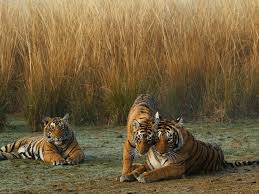Tigers are one of the most iconic and endangered species in the world. The World Wildlife Fund (WWF) is a non-profit organization that works to protect tigers and their habitats around the world. The WWF is dedicated to stopping the decline of tiger populations and ensuring that they have a secure future in the wild.
The WWF’s tiger conservation efforts focus on several key areas, including protecting tiger habitats, preventing poaching and illegal trade of tiger parts, and promoting sustainable development that benefits both people and tigers. The organization also works with local communities to develop conservation programs that are tailored to their specific needs and circumstances.
To achieve its goals, the WWF works with governments, other conservation organizations, and local communities to develop and implement effective tiger conservation strategies. These strategies may include setting up protected areas, providing training and support to park rangers and other wildlife protection staff, and working with local communities to reduce human-tiger conflicts.
In addition, the WWF’s work on tiger conservation is critical to ensuring the survival of this magnificent species. By working to protect tigers and their habitats, the organization is helping to ensure that future generations will be able to enjoy the beauty and majesty of these amazing creatures.
Read Also: All you need to know about opossum Rescue
History and Development of Tiger WWF

Tigers have been a key focus of WWF’s conservation efforts since the organization’s early years. In 1972, WWF launched its first major tiger conservation initiative, the “Save the Tiger” campaign, in response to a steep decline in tiger populations due to habitat loss and poaching.
Over the years, WWF’s tiger conservation efforts have evolved and expanded in response to changing threats and challenges. In the 1980s, WWF worked with governments and conservation organizations in India, Nepal, and Bhutan to establish protected areas for tigers and their prey.
In the 1990s, WWF expanded its tiger conservation efforts to other tiger range countries, including Indonesia, Malaysia, and Russia. The organization also began to focus on the demand side of tiger poaching, working to reduce consumer demand for tiger parts and products in Asia.
In the 2000s, WWF launched the Global Tiger Initiative, a partnership between governments, conservation organizations, and other stakeholders aimed at doubling the number of wild tigers by 2022, the next Chinese Year of the Tiger.
Today, WWF continues to work with partners around the world to protect tigers and their habitats through a range of conservation efforts, including anti-poaching, habitat protection, scientific research, and advocacy and policy.
Objectives of Tiger World Wildlife Fund (WWF)

The World Wildlife Fund (WWF) has several aims and objectives for its tiger conservation program. Some of these include:
Protecting tiger habitats: The WWF works to protect and conserve tiger habitats to ensure that tigers have the space they need to thrive. This includes setting up protected areas, improving habitat connectivity, and promoting sustainable land use practices.
Preventing poaching and illegal trade: Tigers are often targeted by poachers for their skins, bones, and other body parts, which are used in traditional medicine and other products. The WWF works to combat poaching and illegal trade by supporting law enforcement efforts and working with local communities to reduce demand for tiger products.
Promoting sustainable development: The WWF recognizes that economic development is important, but it must be done in a way that is sustainable and benefits both people and wildlife. The organization works with local communities to develop sustainable livelihoods and promote conservation-friendly practices.
Engaging local communities: The WWF believes that local communities are critical partners in tiger conservation efforts. The organization works to engage and empower local communities to develop conservation programs that are tailored to their specific needs and circumstances.
Advocating for policy change: The WWF advocates for policy change at the local, national, and international levels to protect tigers and their habitats. This includes advocating for stronger laws and regulations, better enforcement, and more resources for tiger conservation.
Also, the WWF aims to ensure the long-term survival of tigers in the wild by addressing the many threats that they face and promoting conservation efforts that benefit both people and wildlife.
Read Also: All you need to know about Wild Cat Rescue
WWF’s Role in Tiger Conservation
Protecting tiger habitats: WWF works with local communities, governments, and other partners to preserve and protect the critical habitats of tigers. This includes securing protected areas and corridors that allow tigers to move between habitats safely.
Reducing human-tiger conflict: WWF promotes the use of effective methods to reduce human-tiger conflicts, such as developing early warning systems and implementing safe farming practices. They also work with local communities to raise awareness and support for tiger conservation.
Combating illegal wildlife trade: WWF works to stop illegal wildlife trade by strengthening law enforcement, disrupting trade networks, and reducing consumer demand for tiger products.
Monitoring tiger populations: WWF works with partners to conduct surveys and monitor tiger populations to track their status and trends. This information is used to inform tiger conservation strategies.
Capacity building: WWF supports training and capacity building for park rangers, conservationists, and local communities to help them better protect tigers and their habitats.
Additionally, WWF’s goal is to help protect and increase tiger populations and their habitats, with the aim of ensuring a future where tigers can thrive in the wild.
Tiger Conservation Efforts

Protected Areas: Governments and conservation organizations have established protected areas such as national parks and wildlife sanctuaries to protect tiger habitats. These areas are managed to ensure the survival of tigers and their prey.
Anti-poaching efforts: Poaching is a major threat to tiger populations, and anti-poaching efforts are essential to protect tigers from illegal hunting. This includes strengthening law enforcement, using technology such as camera traps to monitor tiger populations, and working with local communities to reduce poaching.
Habitat restoration: Efforts are underway to restore degraded tiger habitats, including reforestation and habitat management. This helps to increase the availability of prey for tigers and create a healthier ecosystem.
Community-based conservation: Involving local communities in conservation efforts is essential for the long-term success of tiger conservation. This includes promoting sustainable livelihoods that do not rely on illegal activities such as poaching, and empowering communities to participate in conservation efforts.
Education and awareness: Education and awareness campaigns are essential to promote the importance of tiger conservation and the role that individuals can play in protecting tigers. This includes engaging with schools and local communities to raise awareness about the importance of conserving tigers and their habitats.
Research and monitoring: Regular monitoring and research is essential to track tiger populations, understand their behavior, and inform conservation strategies. This includes using technologies such as camera traps and GPS collars to track tigers and monitor their movements.
These conservation efforts require collaboration and partnership between governments, conservation organizations, local communities, and other stakeholders. The goal is to ensure that tigers and their habitats are protected and that tiger populations can recover and thrive in the wild.
Read Also: Online Marketing – Successful Lead Generation Strategy





